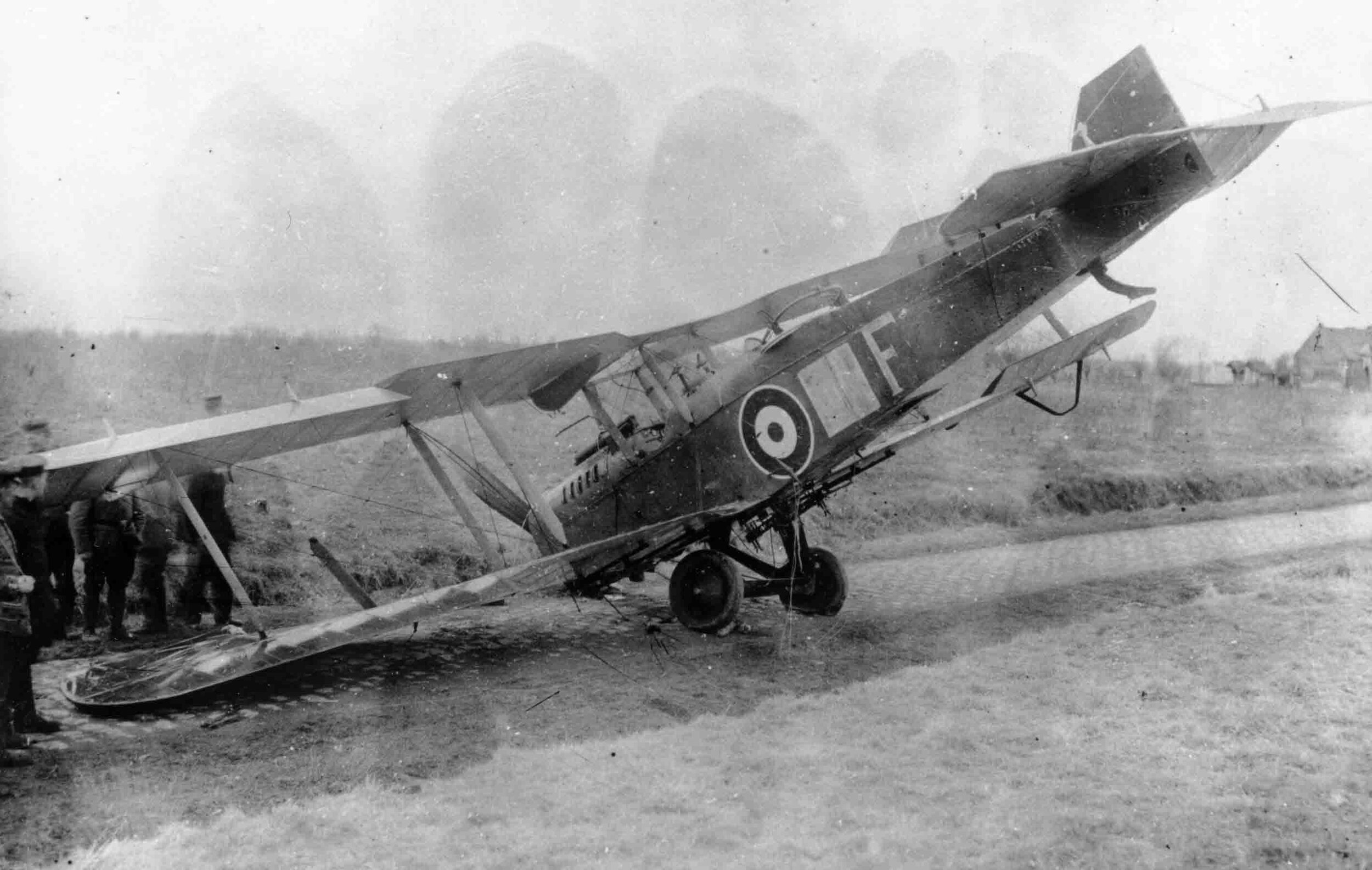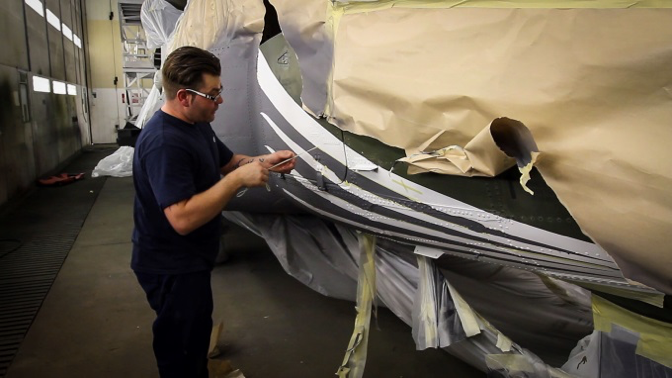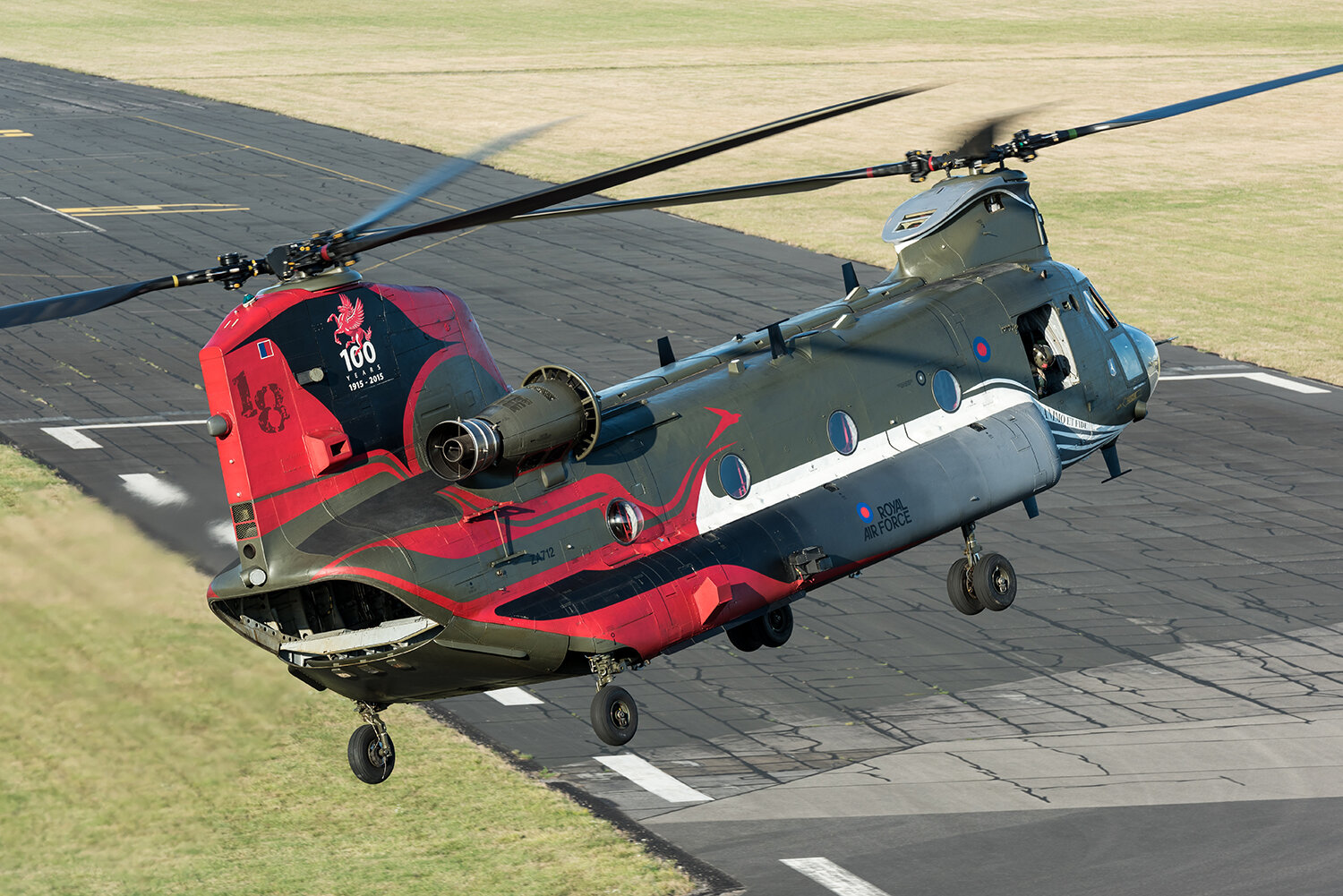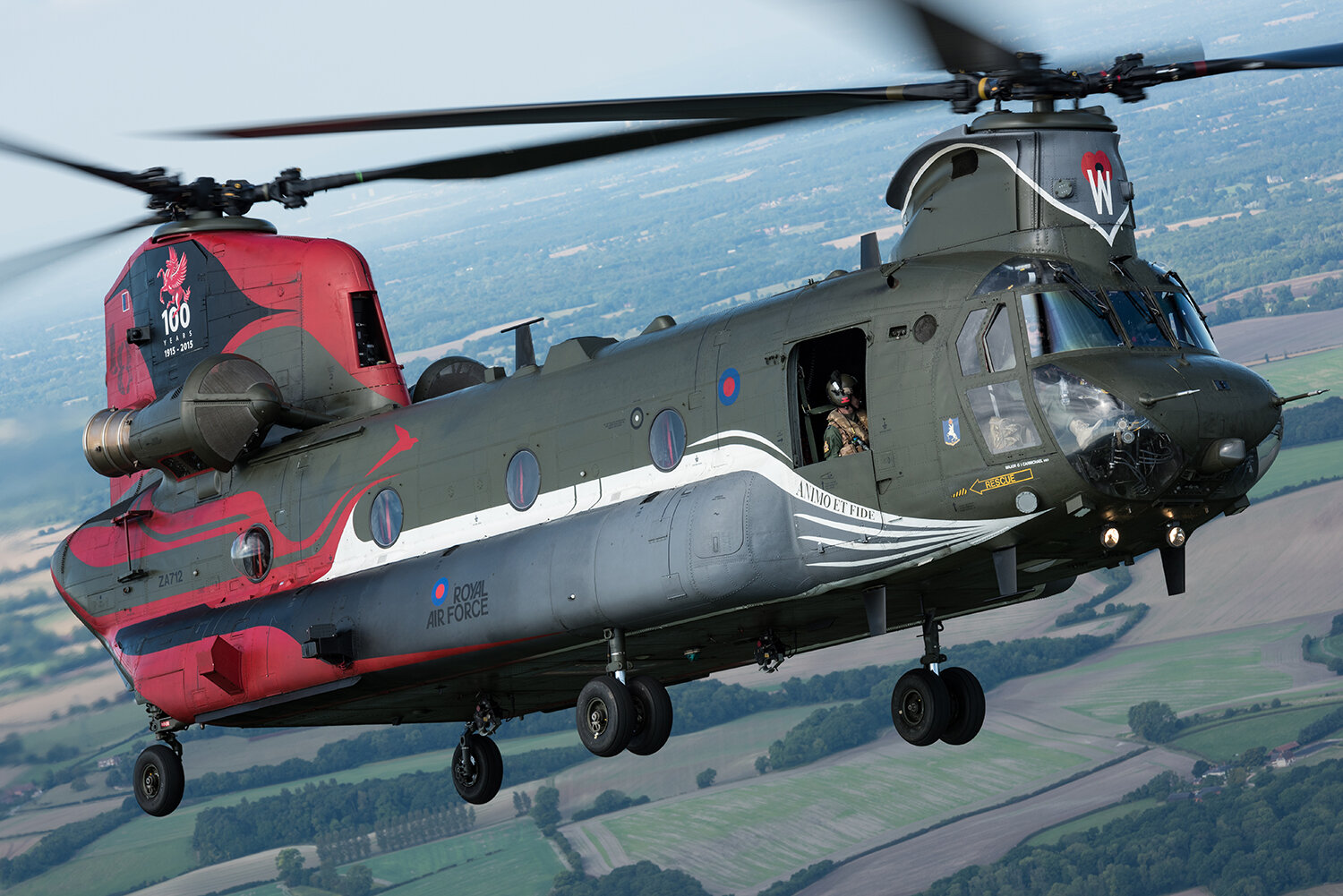It all started when…
A project which started something special and led to a somewhat unforeseen future; out of which a rather unexpected portfolio grew. The suggested was made to put celebratory markings onto a Chinook aircraft in celebration of the 100th anniversary of 18(B) Squadron, which at the time conducted all CH-47 conversion training in the RAF alongside its front-line role. It had been 25 years since large-scale markings were placed onto an RAF Chinook and engineering practices had changed beyond measure so the challenge was to be significant!
This project was completed within the Ministry of Defence and not under Dynamic Vectors. It serves only as an illustration of what some of our designers can do.
Image courtesy 18(B) Squadron Archives.
18(B) Squadron had previously applied a resplendent back end to one of its Chinook HC Mk.1s (ZD980) in 1990. No engineering records existed of how this was done for the 75th anniversary - possibly as it was applied at RAF Gütersloh in Germany and not in the UK - so the team started from scratch. There was an intent from the outset to design a livery which might invoke memories of 1990 but which would still be new in its own right. Engineering authorities imposed several restrictions on design, such as not painting the engines, so the challenge was set!
The Squadron’s executive officer (2nd in command) wished for the livery to incorporate many different pictographic references to that century of history. So, in addition to working out how paint could be applied within a multitude of regulations, the historical research also had to begin! Luckily, the Squadron maintained a superb archive and the Air Historic Branch at RAF Northolt were extremely supportive.
Some particularly wonderful images were found of a Hawker Hart (K2432) taken in June 1934. They caught attention early, due to the style of the ‘18’ displayed on its fuselage. This led to further investigation into how the well-recognised badges of the Royal Air Force squadrons came into existence and inspired further digging into any ‘old-school’ markings which could be incorporated into the centenary Chinook. Sincere thanks are due to the Air Historic Branch for their support in uncovering further details.
Image courtesy The Air Historic Branch, RAF Northolt.
Most RAF squadron badges were approved by King George VI post-1936; although 18 Squadron’s badge is notable as one of very few signed-off in the first batch accepted by King Edward VIII before he left the throne. Up to that time units had created their own imagery with which to identify themselves. For 18, a ‘pegasus rampant’ had endured, having symbolised co-operation with the Cavalry Corps on the Somme during World War I. The project team were overjoyed to discover a shield designed with a white pegasus which had made it onto the side of Squadron aircraft pre-1936 and decided to revive it in 2015.
Image courtesy The RAF Museum, Hendon.
The search continued…as research stumbled across an unusual marking which seemed to be consistent during a short period on 18 Squadron aircraft as they transferred from the Royal Flying Corps (RFC) to the fledgeling Royal Air Force in April 1918. What was this marking? Seemingly a white square, displayed behind the national roundel and in front of each airframe’s identification letter. Numerous in 1917 but disappearing not long after, this seemed a viable addition to the 2015 project as it hinted at the foundation of the Squadron, formed within the RFC in those early days. At this point it was decided to utilise some monotone colours on the front end of the Chinook and full colour towards the back, to hint at the black and white imagery from the past developing into the 21st Century colour.
The war time years offered up very little in terms of unique markings that helped illustrate the Squadron’s lineage. Most RAF aircraft lost overt unit markings during the 1940s as a result of higher priorities and operational security. Equally, photographic records proved sparse for 18 Squadron due to the high tempo of sorties during the war and also their location in Africa. The trail was thus picked up after the war and yet few items of interest were identified for a while. That was until the project team found themselves walking around the corridors at Odiham and stumbled across a picture on the wall, taken of aircrew gathered around an English Electric Canberra B.2 (WH919) at RAF Upwood in January 1956…
Image courtesy 18(B) Squadron Archives.
What was the avian-like shape on the nose of the Squadron’s Canberras? It wasn’t initially clear until finally a photograph of higher definition was attained, showing it up close. It appeared that in the Canberra years only, presumably between August 1953 and its disbandment in February 1957, ahead of the Valiant era, 18 Squadron had carrier a black ‘speed bird’ symbol on its aircraft. This made sense as it had entered the jet age at that point, having relinquished its Dakotas in 1950. Finally, the project team had a marking which would link to the mid-period of the Squadron’s history and decided to feature this very elegant shape as prominently as possible on the side of the Chinook.
Image courtesy The Air Historic Branch, RAF Northolt.
But what of the wartime period? Somehow it did not sit well to not incorporate something which remembered the sacrifices of World War II…and so thoughts turned to one of 18 Squadron’s most famous faces - that of Wing Commander Hugh Malcolm, VC.
Malcolm had been only 25 years old on 4th December 1942 when he led multiple aircraft in an attack on Chougui airfield in Tunisia. 18 Squadron had just landed from a previous sortie when infantry in the region requested urgent air support. Knowing they would have to fly into enemy territory without fighter support and, crucially, by day with very little cloud cover to hide within, Malcolm elected to launch anyway. He knew that the soldiers on the ground were urgently in need of help so he reportedly did not hesitate. Instead he accepted the inevitable hazards and he and his airmen launched to their aid. On arrival, the cloud cover was sparse but he elected not to abandon the troops.
After beginning their bombing runs the Blenheims were overwhelmed by a huge force of enemy fighters - reportedly up to 60 at a time - and every single 18 Squadron aircraft was shot down, including the commanding officer’s Blenheim V, which crashed 15 miles from the target. Then Group Captain Laurence Sinclair later wrote that Malcolm was “one of the bravest officers I had known” and was instrumental in submitting the recommendation which led to 18 Squadron’s late commander being posthumously awarded the Victoria Cross - one of only 26 ever awarded within the RAF. Whilst it was important to recognise the greater sacrifices made beyond Malcolm’s own story, it seemed appropriate to use it subtly in some way which would pay respects to all those who had lost their life in the service of 18 Squadron. The only question that remained, was how…?
In the meantime, the project team had worked closely with the expert engineers in the Chinook Support Centre at RAF Odiham to establish a way forward for the project. A method of defining how the livery should appear on the airframe was developed to take 2D drawings and extrapolate them into 3D. As part of this process the design was chalked onto the side of a Chinook in 18 Squadron’s hangar to provide assurance that the method worked. The Chinook Support Centre served as the lynchpin holding RAF Odiham’s practices in line with the engineering authority for the aircraft based at Abbey Wood near Bristol and without them the project would never have got to this stage.
By then it incorporated a white-to-black fade in recognition of early photographs, a ‘wings of the pegasus’ stylisation towards the front, a broken white line to isolate a single white square mid-fuselage and a wave shape to note the Chinook Force’s growing maritime role leading up into a speed bird graphic towards the back.
With the vast amount of work on engineering documentation, approvals from higher command and paint specialists in place, the time finally came to ‘put pen to paper’ with the aircraft itself. The prime contractor at RAF Odiham had been onboard since the beginning and offered to complete the work within hours already budgeted by the Station, meaning it could be completed at no additional cost over and above the annual charge for routine work. Serco were instrumental in bringing the livery to life. The attitude of their staff proved vital, given that the facility was not ideally equipped for a project this large and so novel approaches had to be developed, with RAF and industry teams working closely along the way to jump various ‘hurdles’ which presented themselves.
The newly decorated Chinook HC Mk.4 (ZA712) was rolled out in front of the gathered masses of 18(B) Squadron on a sunny morning, after several weeks of work. For added effect, approval was gained to fill the paint bay with smoke to add to the atmosphere and therein lay one small error…as, having forgotten to mention that to Air Traffic Control across the airfield, the gathered crowds were most impressed by the reaction speed of the fire crews at RAF Odiham…
ZA712 subsequently went on to perform at RAF Odiham’s Families’ Day and was featured in the BBC Documentary Britain’s Ultimate Pilots: Inside the RAF in the hands of the 2015 Chinook Display Team. It not only told the story of 18 Squadron’s 100 years but also inspired a new generation as to the art of the possible, within aviation and the Royal Air Force.
The aircraft continued its routine tasking role throughout its time in anniversary colours and provided training hours to the crews at Odiham outside of its display and educational duties. Several formation sorties during its life offered opportunity for airborne photographs to be captured forever in the RAF’s archives.
One of the most important features, added in the very final days of the project, was the ‘chip hat’ on the forward rotor pylon of ZA712. Against the grey background was placed the code ‘W’ against a single poppy. The poppy was added with the very kind permission of the Royal British Legion to commemorate lives lost in service, with the single letter serving as a nod to events of 1942 on 18 Squadron. When Wing Commander Hugh Malcolm’s Blenheim V (BA875) was shot down over Tunisia that year, his aviators’ actions earned 18 Squadron great recognition for their combined bravery and valour. Not long before impacting the ground in the attempt to protect troops below, Malcolm’s crew would have boarded their aircraft having identified it from the other Blenheims along the line by its one letter code painted upon the fuselage - ‘W’.
Rather wonderfully, after it was uncovered by research the project team went on to apply 18 Squadron’s RFC badge to the right hand door of ZA712, alongside the name of 18’s first commanding officer. The Squadron has continued to use it informally through to present day! It featured on the menu for the centenary dining-in night in The Officers’ Mess in 2018 and is still worn by some pilots on their flying suits below the approved badge in 2020.
ZA712 formed the backdrop for 18(B) Squadron’s centenary parade in 2018, flanked by two of the Chinook’s forbearers - a Dakota and Blenheim. The latter of the two had only just been returned to airworthy condition! The parade culminated in a perfectly timed three-ship flypast overhead the gathered masses at RAF Odiham.
In 2016 the individuals involved in creating them were ecstatic to be supported by all three Chinook squadrons - 18, 27 and 28 - in flying their aircraft together for the one and only time. A sortie planned over several months, it was an absolutely unforgettable moment.
Photography by Andy Donovan or as credited.
If you would like to know more about what we do then please feel free to follow our social media pages or get in touch for more information on on how you could commission your own livery!

































